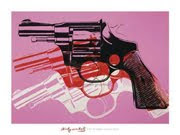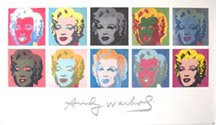 As the consummate artistic recreation of a Pittsburgh boy who was born in a shack-like row house in 1928, Andy Warhol (a.k.a. Andrew Warhola) metamorphosed himself into one of the most enigmatic American artists of the last century. His fascination with ordinary things, things other artists suppressed, helped propel the Pop Art movement in Great Britain and America even further.
As the consummate artistic recreation of a Pittsburgh boy who was born in a shack-like row house in 1928, Andy Warhol (a.k.a. Andrew Warhola) metamorphosed himself into one of the most enigmatic American artists of the last century. His fascination with ordinary things, things other artists suppressed, helped propel the Pop Art movement in Great Britain and America even further. But it wasn't always that way. He was almost always on the brink of being kicked out of Carnegie Institute of Technology's department of painting and design, where he attended art school from 1945 to 1949. Some of his professors felt he had no future in art.
At one point, he was even told that he needed to refine his drawing ability because he wasn't good enough. So Warhol did everything he could to prove them right, and it only proved them wrong. During his last year in college, he placed a greater emphasis on going into commercial art before setting off for New York City.
From commercial illustrator to contemporary artist, but not to him.
 In the early 1960s, Warhol made the move from being a commercial illustrator, inking whimsical shoe advertisements, into painting daily objects of mass production. The first work as a fine artist wasn't seen until 1961, with five paintings used as backdrops behind mannequins at Bonwit Teller department store.
In the early 1960s, Warhol made the move from being a commercial illustrator, inking whimsical shoe advertisements, into painting daily objects of mass production. The first work as a fine artist wasn't seen until 1961, with five paintings used as backdrops behind mannequins at Bonwit Teller department store. But those first few works led to his real passion for painting the ordinary and mundane, notably Campbell's Soup cans and Coke bottles. The success of the first show propelled him to open the Factory in 1962, a place where he could mass produce art, using the same techniques as modern commercial manufacturers.
It was in this free-flowing open mecca for art that Warhol began to experiment as an underground filmmaker, record producer, photographer, and author. It was also here where he began producing iconic, equally mass produced, treatments of celebrities like Marilyn Monroe and Elizabeth Taylor. The point being not to immortalize them, but to celebrate their sameness.
"People think that everyone who came to the Factory was there because of me, that I was some kind of attraction, but that's backwards—I was the one hanging around with everybody else. I just paid the rent, and great people came just because the door was open. They weren't coming to see me, they came to see each other. They came to see who came." — Andy Warhol
 His approach to art was much the same way. During several interviews he said he wished more people would take up silk screens so that no one would know whether some picture was his or somebody else's entirely. He frequently said he wanted to be like a machine, producing work without any real emotional connection to it, not unlike eating a hamburger.
His approach to art was much the same way. During several interviews he said he wished more people would take up silk screens so that no one would know whether some picture was his or somebody else's entirely. He frequently said he wanted to be like a machine, producing work without any real emotional connection to it, not unlike eating a hamburger. Interestingly enough, he might have been amused when that same clip from Jørgen Leth's 1982 film, 66 Scenes from America, first landed on YouTube. Dozens of people imitated it. He might have even liked it better had they simply eaten a burger their own way, only to find out everybody eats them the same way.
One of the few artists in history who aspired to be a machine.
That was part of the point. He didn't make any distinctions in art. Good paintings or good films or good people were all equal in his eyes, even if they were different and especially if they were different. There was no reason to chase sameness, because we were all the same anyway.
 It came across in his art, especially in the 1970s, when critics began calling his celebrity portraits overtly superficial and commercial. The irony, of course, was that Warhol saw that one treatment of Marilyn was as good as any other treatment of Marilyn. And when you put them all together, it is virtually impossible to elevate one over the other.
It came across in his art, especially in the 1970s, when critics began calling his celebrity portraits overtly superficial and commercial. The irony, of course, was that Warhol saw that one treatment of Marilyn was as good as any other treatment of Marilyn. And when you put them all together, it is virtually impossible to elevate one over the other. It would take some time, but some critics eventually came close to getting it right. They said Warhol was providing a brilliant mirror of the times.
The truth was that he didn't want to add depth or significance to his subjects. He stripped them of it in his art because he didn't see that there was any real depth or significance, at least not more than anybody else.
Andy Warhol Prints, Even Mass Produced, For A 9.6 On The Liquid Hip Richter Scale.
Hardly a day goes by without somebody referencing Andy Warhol in a story or headline. He made more than 60 films, wrote four books, and produced countless prints, paintings, and sculptures. While most of his original work is out of reach, anyone can obtain canvas and poster reproductions that capture the essence of the art.
One of the more extensive collections of Andy Warhol prints can be found at Barewalls. While they are not original and cannot capture the various materials Warhol worked into his art (special inks, dyes, and even diamond dust), he might have liked it better. He sometimes considered his work window dressing.
![Liquid [Hip]](https://blogger.googleusercontent.com/img/b/R29vZ2xl/AVvXsEjAFBQPqS7J0-rrttNoRYSsuwIePPZf4Nq6sqDioK1zzVQXJIQXKzq_NVNI4n6h3inuRQFBKOcJeZeSufkdHHIOxbSWyBjTjTxgKEQGyPzdwvkEEeECh4bI5YEGk4RWGUINSd7vulPQsCA/s1600-r/liquidhip.jpg)